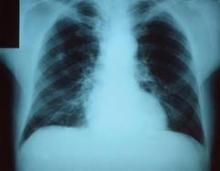Variability in coding of pneumonia cases skewed risk-standardized mortality rates and hospital performance rankings, investigators reported in Annals of Internal Medicine.
The bias could impede efforts to compare quality of care among hospitals, Dr. Michael Rothberg of the Cleveland Clinic in Ohio and his associates said (Ann. Int. Med. Mar. 17 [doi:10.7326/M13-1419]).
The Centers for Medicare & Medicaid Services partially based hospital reimbursements on 30-day risk-standardized mortality rates. To exclude nosocomial pneumonia cases, CMS included only patients with a primary diagnosis of pneumonia when estimating 30-day risk-standardized pneumonia mortality rates.
But over time, hospitals changed how they coded the sickest patients with pneumonia, Dr. Rothberg and his associates said. These patients increasingly received a principal diagnosis of sepsis or organ failure, instead of pneumonia, and thus were excluded from mortality estimates.
"These events gave the false impression that pneumonia outcomes had improved more than they had," they said, adding that "just as changes in coding over time could lead to erroneous conclusions about decreasing mortality rates, variation in coding across hospitals could lead to biased estimates of their relative mortality rates."
The investigators conducted a cross-sectional study of more than 250,000 hospitalizations of adults with a principal or secondary diagnosis of pneumonia at 329 U.S. hospitals between 2007 and 2010.
When the definition of pneumonia excluded patients with primary sepsis or respiratory failure, 4.3% of hospitals had mortality rates that were significantly better than the mean, and 6.4% had rates that were significantly worse. But when the expanded definition was used, 12% of hospitals had mortality rates that were better than the mean, while 23% had rates that were worse. Performance ranking changed for 28% of hospitals.
When the expanded case definition was used, outlier status worsened for 41% of the hospitals with the highest proportions of patients with primary sepsis or respiratory failure, but improved for 20% and worsened for none of the hospitals with the lowest proportions of these patients.
"Efforts to broaden the scope of hospital performance measures from the initial set of measures based on processes to those focused on patient outcomes are laudable, but caution is required," the investigators said. "Misclassification could harm individual hospitals and weaken confidence in public reporting."
Adding principal diagnoses of respiratory failure or sepsis with secondary pneumonia to the definition of pneumonia could help lessen the biases, they said.
The findings "comport with what we see in our own practice," Dr. Scott A. Flanders and Dr. Sanjay Saint said in an editorial accompanying Dr. Rothberg’s report (Ann. Intern. Med. 2014;160:430-1).
"Hospitals caring for a patient with pneumonia coded with sepsis might capture a diagnostic-related group-based payment of more than $15,000 compared with only $6,000 if that patient were coded with ‘just’ pneumonia."
As the investigators pointed out, "the bar for coding a patient with sepsis is low and hospitals interested in appropriately maximizing revenue while accurately reflecting the severity of illness in their patient population will work to clear that bar."
Just as hospitals have changed course and modified their approach to care to better address quality concerns articulated in current measures, the Centers for Medicare & Medicaid Services and others should also learn from "end users" and researchers and adapt their approach to measurement, they said.
"Perhaps we should declare a ‘time-out’ on developing new performance measures until we ensure that the current ones are appropriate and serve their intended purposes."
The study was supported by the Agency for Healthcare Research and Quality.
Dr. James A.L. Mathers Jr., FCCP, comments: This report raises the very important issue of accurate coding and documentation. With the imminent implementation of the ICD-10 system, increased scrutiny of health care services, and the imposition of significant financial penalties for outliers, attention to the new coding and documentation requirements will be crucial for all providers.



